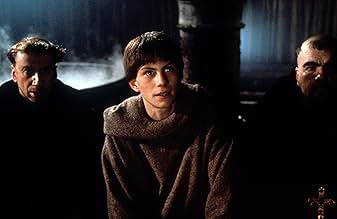Un moine intellectuel enquête sur des morts mystérieuses survenant dans une abbaye isolée, en l'an 1327.Un moine intellectuel enquête sur des morts mystérieuses survenant dans une abbaye isolée, en l'an 1327.Un moine intellectuel enquête sur des morts mystérieuses survenant dans une abbaye isolée, en l'an 1327.
- Victoire aux 2 BAFTA Awards
- 17 victoires et 6 nominations au total
Donald O'Brien
- Pietro d'Assisi
- (as Donal O'Brian)
Histoire
Le saviez-vous
- AnecdotesSean Connery's career was at such a low point when he read for the role that Columbia Pictures refused to finance the movie when Jean-Jacques Annaud cast him as William von Baskerville.
- GaffesThe secret message on the parchment is exposed three times. The translator heated it to reveal the location of the library, William of Baskerville heated it again when he was in the scriptorium and yet again to show the others the message. When a message is written in lemon juice, heating it will cause it to become exposed because the sugar in the juice is caramelized and thus would not disappear again.
- Citations
William of Baskerville: But what is so alarming about laughter?
Jorge de Burgos: Laughter kills fear, and without fear there can be no faith, because without fear of the Devil there is no more need of God.
- Crédits fousThe opening credits read - A palimpsest of Umberto Eco's Novel The Name of the Rose
- Versions alternativesCertain prints of the movie have the sex scene between Adso and The Girl removed in order to comply with local laws.
Commentaire à la une
Umberto Eco's novel has something of a reputation as one of the great unread bestsellers. To have it on the shelf in the early eighties was a fashion statement as much as it was a literary necessity. And yet when the film was released, it was attacked for being an ineffective adaptation. Turning the 600-page novel, a detective mystery enriched by descriptions of medieval life and semiotic ruminations characteristic of Eco's academic writings, into a mainstream two-hour movie was, of course, ambitious. Four credited screenwriters and an international co-production gave off a sense of struggle and indecision. The movie was, and remains, easy to deride.
It's true that the film, directed by Jean-Jacques Annaud, has to skip, or skirt, much of Eco's detail - the famous pages-long description of the doorway, for example, is acknowledged by a few camera shots - but it takes the novel's literary strengths and offers a cinematic equivalent: a vivid depiction of monastic life which thrusts the viewer into the period of the story. In this respect, the production is exemplary: cinematographer Tonino Delli Colli, art director Dante Ferretti and composer James Horner were all operating at the top of their game.
And, as Renton in Trainspotting (1996) knows, Sean Connery proved a perfect choice as William of Baskerville, the 14th-century Sherlock Holmes figure investigating the deaths in an Italian monastery. It's one of Connery's best performances, a happy marriage of character acting and star casting: he suits the physical description of William and he properly conveys the character's wisdom, caution and sense of regret. Christian Slater's Adso, the narrator of the novel, is a surrogate for the viewer, expressing bafflement at the mystery story and awe at William's deductive powers; while F. Murray Abraham works wonders with the underwritten part of the inquisitor Bernardo Gui.
The Name of the Rose is one of the most underrated movies of the eighties. That it wasn't brilliant should not detract from the fact that it's as good as it is.
It's true that the film, directed by Jean-Jacques Annaud, has to skip, or skirt, much of Eco's detail - the famous pages-long description of the doorway, for example, is acknowledged by a few camera shots - but it takes the novel's literary strengths and offers a cinematic equivalent: a vivid depiction of monastic life which thrusts the viewer into the period of the story. In this respect, the production is exemplary: cinematographer Tonino Delli Colli, art director Dante Ferretti and composer James Horner were all operating at the top of their game.
And, as Renton in Trainspotting (1996) knows, Sean Connery proved a perfect choice as William of Baskerville, the 14th-century Sherlock Holmes figure investigating the deaths in an Italian monastery. It's one of Connery's best performances, a happy marriage of character acting and star casting: he suits the physical description of William and he properly conveys the character's wisdom, caution and sense of regret. Christian Slater's Adso, the narrator of the novel, is a surrogate for the viewer, expressing bafflement at the mystery story and awe at William's deductive powers; while F. Murray Abraham works wonders with the underwritten part of the inquisitor Bernardo Gui.
The Name of the Rose is one of the most underrated movies of the eighties. That it wasn't brilliant should not detract from the fact that it's as good as it is.
- edwardlamberti
- 15 sept. 2004
- Permalien
Meilleurs choix
Connectez-vous pour évaluer et suivre la liste de favoris afin de recevoir des recommandations personnalisées
Détails
- Date de sortie
- Pays d’origine
- Langues
- Aussi connu sous le nom de
- The Name of the Rose
- Lieux de tournage
- Kloster Eberbach, Eltville Am Rhein, Hessen, Allemagne(interiors: monastery church)
- Sociétés de production
- Voir plus de crédits d'entreprise sur IMDbPro
Box-office
- Budget
- 30 000 000 000 ₤IT (estimé)
- Montant brut aux États-Unis et au Canada
- 7 153 487 $US
- Week-end de sortie aux États-Unis et au Canada
- 494 571 $US
- 28 sept. 1986
- Montant brut mondial
- 7 153 487 $US
- Durée2 heures 10 minutes
- Couleur
- Rapport de forme
- 1.85 : 1
Contribuer à cette page
Suggérer une modification ou ajouter du contenu manquant






































